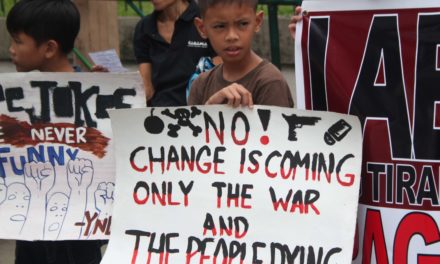Guardian, 1 April 2002
Ita Ajarul, a copra farmer, got up before dawn as usual and went to the well to wash in preparation for prayers two Sundays ago. But he never made it home. According to his wife, Haring, he was stopped by soldiers, arrested and killed. Pregnant, and with two small children, she was forced out of the house and fled to relatives nearby. “Everyone was running when the soldiers came, they don’t speak our language, they just made us go,” she said.
Haring and her sister-in-law came to Basilan’s capital, Isabela City, last week to meet delegates from the Philippines House of Representatives who visited the island to hold hearings on human rights violations by the security forces.
Basilan, seen from the ferryboat, looks like a peaceful island paradise of white sands, palms, coconut trees and dense forest. In fact it is an island of fear, where death and disappearance are random. The three congressional representatives did not sleep overnight, the last foreign priest left for mainland Mindanao under orders from the Vatican and our group was guarded by two dozen heavily armed policemen and many plain clothes guards.
Dozens of other witnesses like these peasant women never made it to Isabela City – either because of the difficulty of moving through the checkpoints and the ongoing military exercises against the Abu Sayyaf group, or because they had been intimidated.
Basilan, poor, Muslim, and for 30 years a violent and forgotten corner of the world, has now become a second front for the US international war on terrorism. Under a $100m six-month agreement, 600 US troops are in Mindanao (160 of them now in Basilan), and there are reports that more may be sent.
The US deployment, known as Balikatan (meaning shoulder to shoulder), is described as a training mission, but the heady combination of reported links of Abu Sayyaf to al-Qaida (though the Philippine government has stated that 1995 is the last record of such links), and two American hostages, are in the subtext.
Above an idyllic bay at the end of a rutted jungle road leading to their camp, American soldiers sit at breakfast under banana and papaya trees and bushes of orange and crimson bougainvillea. The Philippine military, 6,000 or so on the island, are already well trained and described by one US major as “excellent soldiers”.
The Abu Sayyaf hostage and ransom specialists are not a political or ideological group. Now numbering only about 60 to 70 people, they have powerful protectors, according to islanders who have been their victims. Waves of arrests have taken place recently, without warrants but on the word of hooded men driven into villages to point out suspects as Abu Sayyaf supporters. But who is menacing whom? Isabela City alone has as many as 500 militias, according to the governor, Wahab Akbar. Their shifting allegiances are secured by cash, family and clan ties.
It is a decade since mass protest in the Philippines forced the US out of their bases in the country. Their return is highly popular in elite circles in Basilan, where the governor told us they would be welcome to stay as long they want, have a nuclear base or even take over Basilan as a new province of the US.
But the former senator Wigberto Tanada spoke for others when he said: “I do not believe Balikatan consists of mere joint training exercises. It includes actual US involvement in combat operations… these troops will be staying in Mindanao for as long as it takes to to protect US interests.”
“We have to look at the problem of terrorism in a larger perspective, why militant Islam is luring Muslim youth and how pseudo-Islamic groups like the Abu Sayyaf are able to play on such trends.”
* Victoria Britain was a member of the Peace Mission to Basilan. She was formerly foreign editor of The Guardian and is presently writing a report on women and war for UNIFEM.







